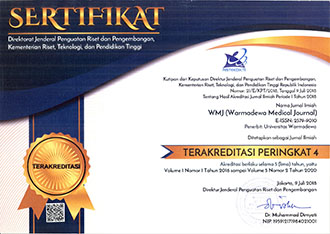Penerapan Mind Map pada Mahasiswa Blok Special Topic (Pirene) di Fakultas Kedokteran dan Ilmu Kesehatan (FKIK) Universitas Warmadewa
Abstract
Mind map merupakan metode penyusunan catatan demi mengoptimalkan seluruh potensi otak. Metode ini memungkinkan daftar informasi yang panjang dialihkan menjadi diagram yang dikombinasikan dengan berbagai warna, simbol, dan gambar, sehingga memudahkan otak dalam menyerap. Penerapan metode ini dalam pembelajaran diharapkan dapat membantu mahasiswa mencapai tujuan belajar. Tujuan dari penelitian ini adalah untuk mengetahui pengaruh penerapan metode pembelajaran mind map terhadap motivasi dan kelulusan mahasiswa Fakultas Kedokteran dan Ilmu Kesehatan (FKIK) Universitas Warmadewa pada Blok Special Topic (Pirene). Selama Blok berlangsung setiap mahasiswa membuat mind map sesuai dengan kasus (pemicu) dalam Modul Blok. Motivasi mahasiswa terhadap penerapan mind map dievaluasi menggunakan kuesioner dan evaluasi kelulusan mahasiswa ditentukan menggunakan nilai ujian akhir menggunakan multiple choice question (MCQ). Rerata peningkatan motivasi belajar mahasiswa melalui penerapan mind map sebesar 82,2%. Kelulusan first taker mahasiswa mencapai 84,48% dengan nilai A sebesar 53,45% dan nilai B sebesar 31,03%. Mahasiswa dengan nilai mind map assessment rubric (MMAR) >1000 ternyata 100% lulus ujian akhir, walaupun masih belum jelas adanya korelasi langsung antara nilai MMAR dengan kelulusan mahasiswa tersebut. Penerapan metode pembelajaran mind map pada Blok Special Topic (Pirene) berdampak baik terhadap peningkatan motivasi belajar mahasiswa dan kelulusan first taker mahasiswa.
Kata Kunci: mind map, Blok Special Topic (Pirene), motivasi belajar, kelulusan
Â
[The Application of Mind Map on College Student Block Special Topic (Pirene) in Faculty of Medicine and Health Science, Warmadewa University]
Mind map is a note-taking strategy to optimize the brain potential. This method allows a long list of information, transferred into a diagram combined with a variety of colors, symbols, and images, making it easier for the brain to absorb information. Application of this method as a learning strategy is expected to help students achieve the learning objectives. The aim of this study was to determine the effect of the application mind map as learning methods toward motivation and graduation in medical faculty students on Block Special Topic (Pirene). During the Block takes place, each student create a mind map accordance with the case (triggers) in Block Module. Motivation of students to the application of the mind map was evaluated using questionnaires and evaluation of student graduation is determined using the value of the summative MCQ exam. The mean of student motivation to learn through the implementation of a mind map was 82.2%. First taker graduation of students reaching 84.48% with a value of A was 53.45% and the value of B was 31.03%. Students with grades MMAR> 1000 was 100% pass the exam summative, although it is still not clear the direct correlation between the value of the MMAR with students graduation. The application of mind map on the Block Special Topic (Pirene) works to increase the student motivation to learn and graduation of first taker students.
Keywords: mind map, Block Special Topic (Pirene), motivation to learn, graduationReferences
Anderson, J., Graham, A. (1980). A problem in medical education: Is there an information overload? Med Educ,14:4-7.
Buzan, T., Buzan, B. (1993). The Mind Map Book: how to use radiant thinking to maximize your brain’s untapped potential. London, England: BBC Books.
Spencer, J.R., Anderson, K.M., Ellis, K.K. (2013). Radiant thinking and the use of the mind map in nurse practitioner education. J Nurs Educ, 52(5):291-293.
D’Antoni, A.V., Zipp, G.P., Olson, V.G., Cahill, T.F. (2010). Does the mind map learning strategy facilitate information retrieval and critical thinking in medical students? BMC Medical Education, 10:61.
D'Antoni, A.V., Zipp, G.P., Olson, V.G. (2009). Interrater reliability of the mind map assessment rubric in a cohort of medical students. BMC Medical Education. 9:19.
Gayatri, D. (2004). Mendesain Instrumen Pengukuran Sikap. Jurnal Keperawatan Indonesia, 8(2):76-80.
Daley, B.J., Torre, D.M. (2010). Concept maps in medical education: an analytical literature review. Medical Education. 44: 440–448.
Zhou H,C,. Shao, S.W., Xu, B.Y. (2012). Application of mind map in teaching of medical parasitology. Zhongguo Ji Sheng Chong Xue Yu Ji Sheng Chong Bing Za Zhi. 30(6):477-9.
Noonan, M. (2013). Mind maps: Enhancing midwifery education. Nurse Educ Today. 33(8):847-852.
Farrand, P., Hussain, F., Hennessy, E. (2002). The efficacy of the 'mind map' study technique. Med Educ, 36(5):426-431.
 Abstract viewed = 548 times
Abstract viewed = 548 times
 PDF (Bahasa Indonesia) downloaded = 633 times
PDF (Bahasa Indonesia) downloaded = 633 times





